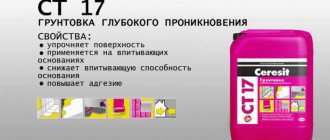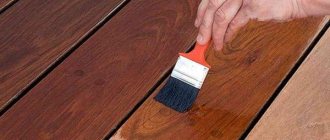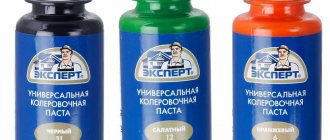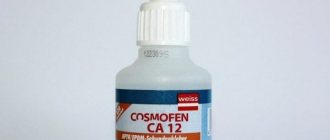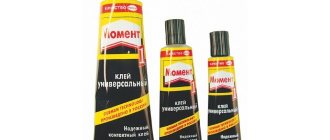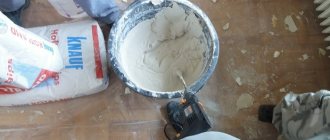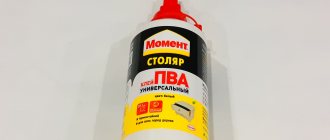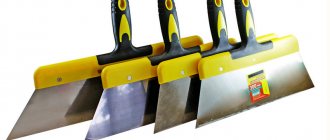Primers FL-03K and FL-03Zh were developed in the late 70s of the twentieth century, but are still very popular.
It is important to note that the scope of application of FL-03K
and
FL-03Zh
is diverse:
- mechanical engineering;
- bridge construction;
- machine tool industry;
- metal structures and structures;
- automotive industry;
- military-industrial complex;
- railway equipment.
FL-03 primer is produced in accordance with GOST 9109-81 and is a suspension of pigments and fillers in a film former based on phenol-formaldehyde resins modified with vegetable oils.
Primer FL-03K is used for priming surfaces of both ferrous metals and non-ferrous metals - copper and titanium alloys. It is allowed to apply primer FL-03K on wooden surfaces.
The purpose of the FL-03Zh primer is to prime surfaces made of ferrous and non-ferrous metals and their alloys, as well as wooden surfaces.
Properties of phenol-formaldehyde primers
Speaking about the properties of paints and varnishes ( paint and varnish )
, their characteristics should be divided into two groups: the properties of the original paintwork material and the properties of the paint and varnish coating (LPC) formed on its basis.
So, what technical characteristics should high-quality primers FL-03K and FL-03ZH have?
Firstly, this is, of course, conditional viscosity. For both primers, the lower limit of viscosity is determined by GOST 9109-81 - 40 s using a VZ-4 viscometer at a paintwork temperature of 20 °C. The upper limit is not specified by GOST, but from practical experience we can say that it is approximately 140 s.
The next important quality indicator is the mass fraction of non-volatile substances, or, more simply, the dry residue. The dry residue refers to the non-volatile part of the film former and the pigment part - i.e. everything that remains after the solvents evaporate. For the FL-03K primer it is in the range of 58 – 64%, for FL-03Zh – 55 – 61%. The deviation of the actual value of this indicator from the GOST requirement (usually upward) means that the manufacturer saved on the binder and replaced part of the expensive phenolic varnish with a cheap filler (talc or chalk), diluting the primer with a solvent to the required viscosity. A coating based on such a primer will have worse physical and mechanical properties (adhesion, elasticity, impact strength).
The degree of grinding or dispersion is an indicator that affects the structure, appearance and gloss of the coating. The degree of grinding is nothing more than the size of the particles of pigments and fillers in the primer. The lower this indicator, the more even, uniform and smooth the coating will be. For FL-03K, the degree of grinding is no more than 40 µm, for FL-03zh – no more than 30 µm.
Recommended solvent
First, before application, you need to thoroughly mix the primer, checking its viscosity at the same time - it, like any paint, can thicken. Thinner can be added up to 20% of the total primer volume. This is solvent, xylene, or a mixture of them with white spirit in equal parts. After dilution, stirring is mandatory.
At the same time, it is also recommended to add siccatives ZhK-1 or the more universal NF-1 to the FL-03K primer - for faster drying of the applied coating. Driers also improve surface-active tension and increase surface wettability. When adding a drier, you must not exceed its permissible content - 4% of the total mass, that is, add no more than four parts of a drier to one hundred parts of the primer.
Properties of FL-03 and FL-03Zh primer coatings
The first two indicators that everyone pays attention to are the color and appearance of the primer film. After application to the surface, phenolic primers form a smooth, uniform matte, semi-matte or semi-gloss coating, for FL-03K - brown, for FL-03Zh - yellow-green.
Please note that the shade of the primer
not standardized. For a primer overlaid with enamel, this does not matter, but if you want to use the primer as a finishing coat (for example, for painting a garage, large metal structure, etc.) and take several containers of primer, it is better to take all containers from one batch or, if possible, mix them before applying the primer. Otherwise, the different shades of the coating may become an unpleasant surprise.
A very important indicator is the drying time of the primer. Primers FL-03Ki FL-03Zh must dry under normal conditions within 8 hours. Hot drying is also provided - at a temperature of 105 ° C for 35 minutes. By the way, about the drying speed of paintwork materials - the longer the drying time, the better the physical, mechanical and protective properties of the formed coating. Therefore, when choosing between faster and slower drying paintwork materials, you are actually choosing between the speed of painting work and quality.
The next group of technical indicators determines the physical and mechanical properties of the coating: film adhesion, film hardness, film elasticity during bending, film strength upon impact.
The primer is the primary layer of complex paintwork; it is responsible, first of all, for adhesion to the substrate (the surface to be painted) and subsequent layers. The strength of such a coupling (adhesion) is assessed in points: 1 point - maximum, 4 points - minimum, practically absent. For primers FL-03K and FL-03, Jadgesia should be 1 point.
Film hardness is measured using a pendulum device. The essence of the method is to determine the time (number of oscillations) during which the amplitude of damped oscillations of a pendulum placed on a paint coating decreases by a given amount. In paintwork with low hardness, the pendulum seems to “get stuck”, quickly loses speed and the number of its oscillations is very small. The harder the coating, the greater the number of oscillations the pendulum will make. We can say that the “Film Hardness” indicator indirectly characterizes the resistance of the coating to abrasion. Primer films FL-03K and FL-03 have a fairly high hardness - no less than 0.3 according to a TML-type pendulum device.
The elasticity of a coating is nothing more than the strength of the coating when bending at a certain angle, which indirectly characterizes its flexibility, i.e. property opposite to fragility. It is measured using a flexibility scale - a set of rods of different diameters. The smaller the radius of the rod, the greater the bending angle, the higher the elasticity of the coating. Coatings FL-03K
and
FL-03Zh
have maximum elasticity - 1 mm (minimum radius).
Impact strength is an indicator that characterizes the resistance exerted by the coating upon penetration of another body, in this case, a striker of a certain shape and weight, falling on a metal plate coated with a primer from a certain height. The greater the height of the striker fall, the greater the impact on the coating. The coating must withstand impact without tearing, creasing or other damage to integrity. Primer coatings FL-03K
and
FL-03Zh
have a maximum impact strength of 50 cm.
And the last group of indicators regulated by GOST 9109-81 is the resistance of the coating to aggressive environments (corrosive agents, solvents, fuels and lubricants). Primer films FL-03K
and
FL-03Zh
provide resistance to industrial oil for 72 hours and to a 3% NaCl solution for 24 hours.
Application of FL primers
Fl03k primer is produced for processing metal products made of ferrous and non-ferrous metals, including ideal for copper and titanium-based alloys, as well as for priming wooden bases. Primer fl-03zh is well suited to various non-ferrous alloys.
The use of a primer ensures high adhesion, durability, and anti-corrosion resistance of the entire paintwork system.
FL primers are used to coat treated solid wood due to their excellent adhesion to the wood.
Instead of fl03k, you can use fl03zh primer. It also has high adhesion to metal and wood. This primer is ideal for coating products made of non-ferrous alloys
Primer thinner FL-03K
Immediately before use, the primer must be thoroughly mixed throughout the entire volume of the container until it has a uniform consistency. Then a drier (usually NF-1 or ZhK-1) should be added to the primer in an amount of no more than 4% of the primer weight and mixed thoroughly.
a drier into it already at the manufacturing stage. Information about the presence of a drier in the primer must be included in the quality certificate and on the label. This primer does not require additional introduction of a drier.
Then the primer is diluted to working viscosity with a solvent - solvent, xylene or a mixture of one of these solvents with white spirit in a 1:1 ratio by weight. It must be remembered that the working viscosity of paintwork materials depends on the application method. When applying the primer by air spray, the viscosity should be in the range of 20 - 30 s, by airless spray - 40 - 60 s, by roller and brush - over 60 s or not diluted at all. Viscosity is indicated using a VZ-246 viscometer with a nozzle diameter of 4 mm at a temperature of 20 °C. As a rule, the ambient temperature during painting should be in the range of +5 – +35 oC, humidity – no more than 85%.
After the primer layer has dried, enamel .
Primer coatings FL-03K and FL-03Zh are compatible with almost all types of enamels, with the possible exception of silicone ones.
Soil FL-03K and FL-03Zh GOST 9109-81
Primers FL-03 GOST 9109-81is a suspension of pigments and fillers in a varnish based on synthetic phenol-formaldehyde resins modified with vegetable oils with the addition of solvents.
Primers
FL-03 GOST 9109-81
are intended for priming surfaces made of ferrous metals, copper and titanium alloys, as well as wooden surfaces.
Primer films are resistant to temperature changes from -60º to +100°C.
FL-03
primers are applied to the surface by spraying, dipping or brushing.
It is allowed to apply the FL-03K
primer to the surface using the jet method.
Before use in primers FL-03 GOST 9109-81
NF-1 (GOST 1003) or ZhK-1 (TU 6-10-1641-86) drier
is introduced in an amount of no more than 4% by weight of the primer.
The brand of drier must be indicated in the regulatory and technical documentation for painting products. Mix thoroughly and dilute to working viscosity with solvent
(
GOST 10214 or GOST 1928
),
xylene
(
GOST 9949 or GOST 9410
) or a mixture of one of the above solvents with
white spirit
(nefras
GOST 3134
) by weight 1:1.
The surface must be degreased with a solvent (acetone) or alcohol. After degreasing, it is recommended to treat the metal surface with a rust converter from the Orthoprotect series.
Drying time for a single-layer coating at a temperature of (20±2)°C is 8 hours.
Physical and mechanical properties of soil FL-03 GOST 9109-81
are given in the table
Indicator name
| Norm | Test method | |
| Primer film color | Brown, Yellow-green, shade is not standardized | GOST 9109-81 clause 4.3 |
| Film appearance | After drying, the film should be smooth, uniform, matte or semi-matte or semi-gloss | GOST 9109-81 clause 4.3 |
| Conditional viscosity at (20.0±0.5)°С according to the VZ-4 viscometer, s, not less | 40 | According to GOST 8120-74 |
| Degree of dilution with solvent, %, no more | 20-25 | GOST 9109-81 clause 4.4 |
| Mass fraction of non-volatile substances, % | 58-64 | According to GOST 17537-72, and GOST 9109-81 clause 4.5 |
| Degree of grinding, microns, no more | 30-40 | According to GOST 6589-74 |
| Drying time to degree 3, no more at (20±2) °C, h | 8 | According to GOST 19007-73 |
| Film hardness according to the pendulum device M-3, conventional units, not less | 0,36 | According to GOST 5233-89 |
| Film elasticity when bending, mm, no more | 1 | According to GOST 6806-73 |
| Film strength upon impact on a U-1 type device, cm, not less | 50 | According to GOST 4765-73 |
| Film adhesion, points, no more | 1 | According to GOST 15140-78, section 2 |
| Film resistance to static action of 3% sodium chloride solution at (20 ± 2) °C, h, not less | 24 | According to GOST 9.403, section 2 and GOST 9109-81 clause 4.8 |
| Film resistance to static effects of industrial oil at a temperature of (20 ± 2) °C, h, not less | 72 | According to GOST 9.403, section 2 and GOST 9109-81 clause 4.9 |
| The ability of the coating to be sanded | When sanding, the coating should form a smooth surface and not stain the sandpaper. | GOST 9109-81 clause 4.10 |
| The formation of sediment during storage is allowed if, after thorough stirring and dilution according to indicator 4 of the table. 1 primer will meet all the requirements of this standard. | ||
Packaging, labeling, transportation and storage of soil FL-03K and FL-03Zh
- according to
GOST 9980.3-86 - GOST 9980.4
.
When marking transport containers, a manipulation sign “Keep away from heat” is applied in accordance with GOST 14192
, danger sign according to
GOST 19433
(class 3, classification code 3313 and UN registration number 1139).
The guaranteed shelf life of the primer
FL-03K and FL-03Zh
is six months from the date of manufacture.
Primers FL-03K
and
FL-03Zh
are fire hazardous and toxic materials, which is due to the properties of the solvents and chromates included in the primers. Solvent vapors included in primers have an irritating effect on the mucous membranes of the eyes, respiratory tract and skin.
The dried coating has no harmful effects on the human body and the environment.
Primer
FL-03K and FL-03Zh
should be stored in a tightly closed container, protected from moisture and direct sunlight. Keep away from fire. If a film forms on the surface of the primer during storage, it should be removed before use and the primer should be thoroughly stirred. When carrying out painting work, as well as after its completion, it is necessary to thoroughly ventilate the room. Rubber gloves are used to protect hands.
